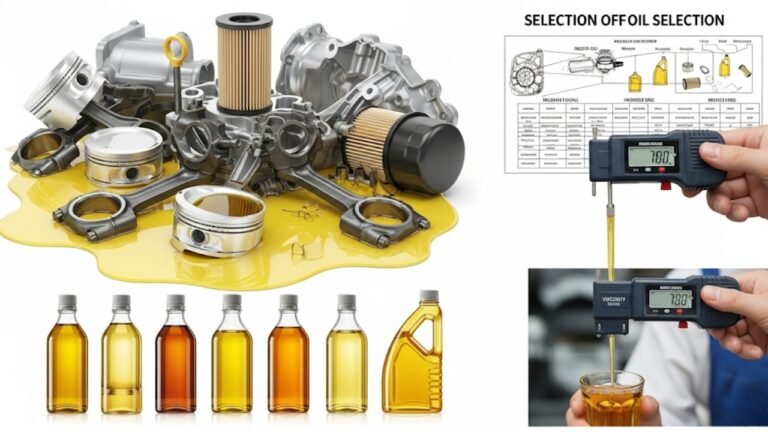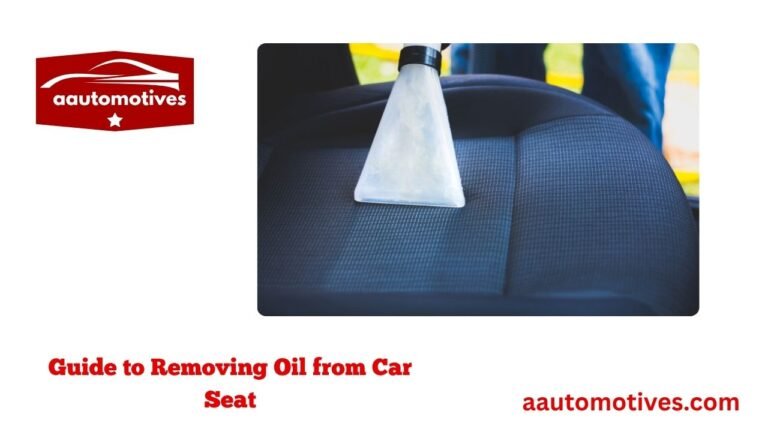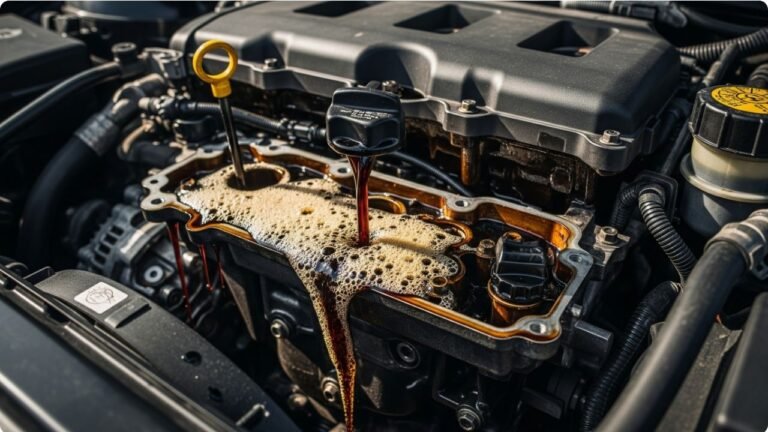9 Clear Signs of Oil Leak in a Car
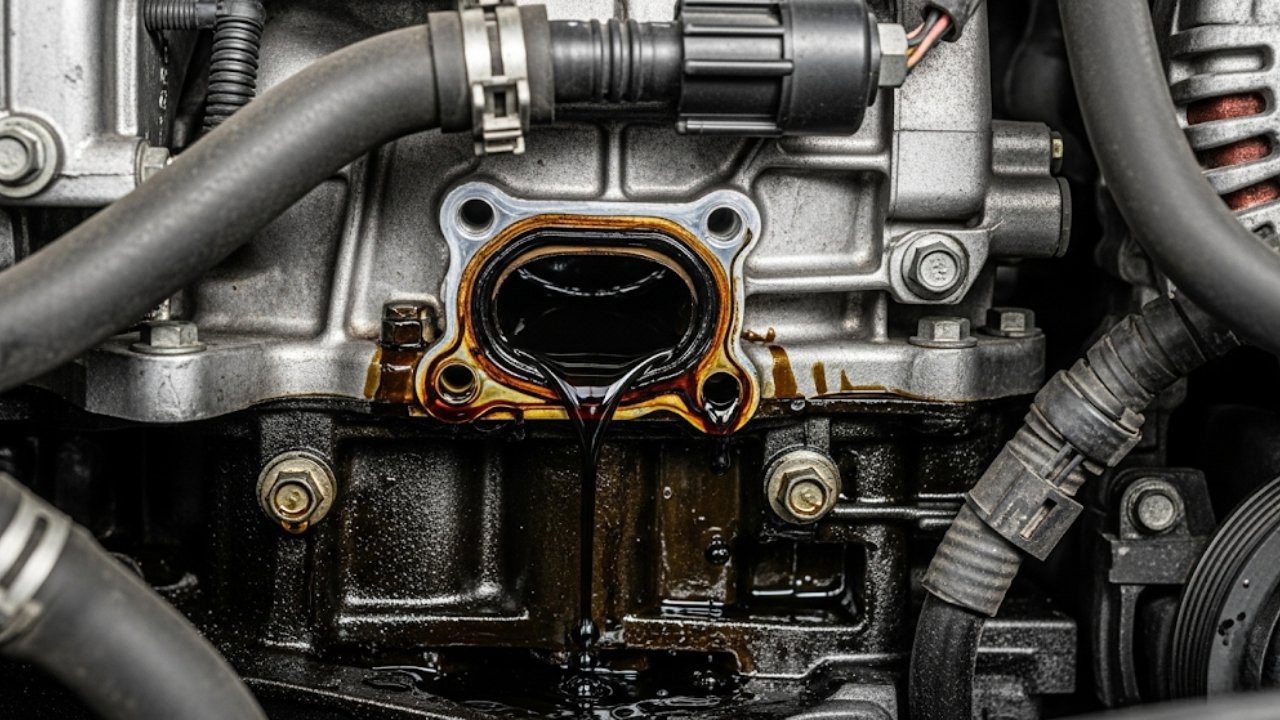
We’ve all been there. You park your car in the garage or driveway, and the next time you move it, you see a strange, dark spot left behind. That little blotch on the concrete? It could be your car’s way of crying for help.
An oil leak in a car isn’t just a mess on your driveway. It can be a serious warning sign that your engine isn’t getting the lubrication it needs to stay cool and efficient. Ignoring it might lead to expensive repairs, reduced performance, and even engine failure. Whether you’re a seasoned driver or just started learning how to check your car’s fluids, understanding the signs of oil leak car issues is crucial.
In this guide, I’ll walk you through the most common (and sometimes surprising) symptoms that your car might be leaking oil. I’ll also share some personal insights, tips from mechanics, and what you can do before things get worse.
1. Oil Spots Under the Car – The Most Obvious Clue
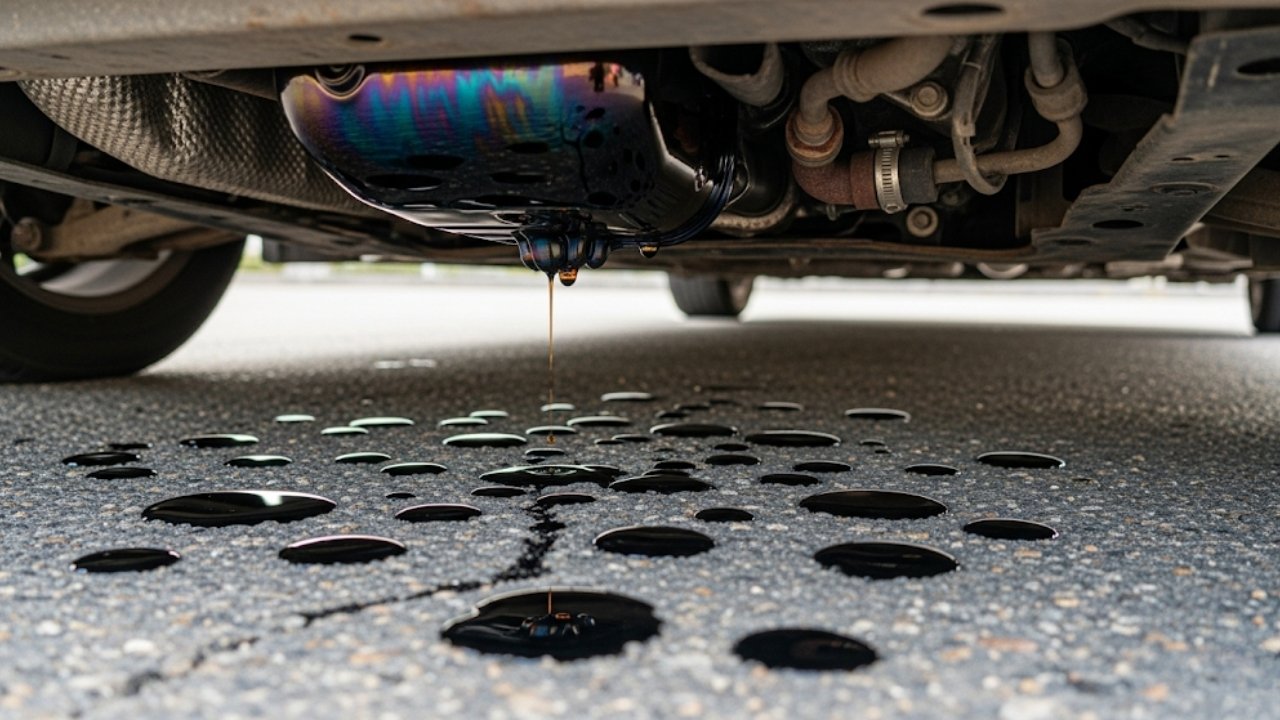
What Does It Look Like?
-
Dark brown to black
-
Slick and greasy
-
Slightly shiny in the sunlight
If you touch it, it’ll feel slick and thin, especially when fresh. Don’t confuse it with coolant (which is often green or orange), or transmission fluid (which may be red).
What To Do:
-
Slide a white paper towel or cardboard under your engine overnight.
-
Check the color and location of any drips.
-
Oil leaks often appear under the engine, close to the front middle.
Pro tip: If it’s only a drop or two occasionally, it might be minor. But if it’s consistent, it’s time to act.
2. Burning Oil Smell Inside the Cabin
Ever smelled something strange—almost like hot metal or smoke—while driving? That sharp, slightly sweet burnt smell might mean oil is leaking and dripping onto hot engine parts like the exhaust manifold.
Why It Happens:
When engine oil leaks onto hot components, it doesn’t just vanish. It burns. And that smell? It’s your car’s way of sounding the alarm.
Real Talk:
I once ignored this smell for weeks. I thought it was just the old engine warming up. But later, it turned out oil had been leaking slowly onto the exhaust manifold. Eventually, it scorched the gasket and cost me nearly $400 in repairs.
3. Low Oil Levels Without Warning Lights
You know that little yellow oil can icon on your dashboard? It’s meant to warn you when your oil pressure drops. But here’s a twist — you can have a serious oil leak without that light ever coming on.
Here’s Why:
That sensor only activates when oil pressure gets dangerously low. So if you’re leaking slowly, your engine might be quietly running dry.
What You Can Do:
-
Check your dipstick weekly, especially if your car has over 100,000 km.
-
Keep track of how often you top up oil.
-
If you’re topping up more than once a month, something’s wrong.
Important: A slow leak might not leave spots under the car but could still reduce performance or fuel efficiency.
4. Smoke from the Engine Bay
If you pop your hood and see a hazy smoke or steam, don’t panic. But don’t ignore it either.
What’s Happening?
Leaked oil is burning on a hot surface, like:
-
The exhaust manifold
-
Engine block
-
Catalytic converter
You might also see whitish smoke coming from under the hood, especially after a drive or in warm weather.
Next Steps:
-
Check for oil residue on engine components.
-
Look for burnt areas around seals or gaskets.
-
Visit a mechanic immediately. This could become a fire risk.
5. Engine Overheating
Oil isn’t just there to lubricate your engine. It also helps regulate heat. If there’s not enough oil in the system due to a leak, your engine can run hotter than normal.
Signs of Overheating from Oil Loss:
-
Temperature gauge rising above normal
-
Engine fan running constantly
-
A strange ticking or knocking sound
Possible Causes:
-
Leaky valve cover gasket
-
Worn-out oil filter seal
-
Loose or cracked oil drain plug
Here’s a table for reference:
| Leak Source | Common Location | Fix Cost (Approx.) |
|---|---|---|
| Valve Cover Gasket | Top of engine | $150 – $400 |
| Oil Pan Gasket | Bottom of engine | $200 – $600 |
| Oil Filter Housing Gasket | Near oil filter | $100 – $300 |
| Rear Main Seal | Between engine & transmission | $500 – $1500 |
Note: Prices vary depending on your car’s make and model.
6. Dashboard Warning Lights (When They Do Work)
Even though we said earlier that you might not always see the oil light come on, sometimes it does — and when it does, take it seriously.
Key Dashboard Alerts:
-
Oil pressure light: shaped like an oil can with a drip.
-
Check engine light: may come on due to oil-related issues like bad pressure or misfiring.
If either of these lights pops up and you notice poor performance or strange sounds, pull over and check your oil level immediately.
7. Engine Running Rough or Misfiring
When oil seeps into places it shouldn’t — like the spark plug wells or combustion chamber — it can cause misfires. Your engine might stutter, lose power, or even stall when accelerating.
Why It Matters:
Oil-fouled spark plugs reduce combustion efficiency, meaning:
-
Worse fuel economy
-
Sluggish response
-
More emissions
It’s like your car is trying to run a marathon while breathing through a straw.
8. Blue Smoke from the Exhaust Pipe
This one’s hard to miss. If your car starts puffing blueish-gray smoke from the tailpipe, it usually means oil is being burned inside the engine.
Common Causes:
-
Worn piston rings
-
Valve seals
-
PCV system failure
Unlike white smoke (which suggests coolant leaks) or black smoke (fuel issues), blue smoke is all about oil.
9. Gunk Around Engine Seals and Parts
Sometimes, the signs are hiding in plain sight. Pop your hood and inspect these areas:
-
Around the valve cover
-
Near the oil cap
-
Bottom of the engine block
-
Oil filter area
You might see sticky brown residue or built-up grime. That’s leaked oil mixing with dirt — and it’s a clear giveaway that something’s not sealed properly.
What Causes Oil Leaks in Cars?
Understanding the root causes of oil leaks can help you act faster and smarter. These leaks don’t happen randomly. They usually start from wear and tear, poor maintenance, or a damaged part.
Top Reasons Why Oil Leaks Happen:
-
Worn-out Gaskets and Seals
These rubber or silicone components are designed to keep oil in place. Over time, heat and pressure harden or crack them, especially in older cars. -
Loose or Damaged Oil Filter
If your oil filter isn’t tight, or if the rubber seal is torn, it can cause oil to leak right after a change. -
Cracked Oil Pan
Road debris or speed bumps can damage the oil pan, causing slow but steady leaks. -
Bad Valve Cover Gasket
This is one of the most common oil leak spots, especially in cars over 5 years old. It often leaks down the side of the engine. -
Leaking Oil Drain Plug
When you change oil, the plug is removed and reinstalled. If it’s over-tightened or cross-threaded, it can cause a leak. -
Failing Rear Main Seal
This one’s deep in the engine and connects it to the transmission. If it leaks, the repair is often expensive and time-consuming.
Bullet Recap:
-
✅ Old seals or gaskets
-
✅ Loose oil filter
-
✅ Cracked oil pan
-
✅ Leaking drain plug
-
✅ Failed rear main seal
Tip: Regular oil changes and using the right oil type can reduce stress on seals and prevent leaks.
How to Fix an Oil Leak
Now comes the big question: Can you fix an oil leak yourself? Sometimes yes. Other times, it’s a job for a mechanic.
1. Tighten Loose Components
-
Check the oil cap and drain plug. Are they snug?
-
Look at the oil filter. If it’s loose, tighten it by hand (not too hard).
2. Replace Gaskets or Seals
If you find the valve cover gasket is leaking, you can usually replace it at home with basic tools. But if it’s the rear main seal, take it to a professional.
3. Use Oil Leak Stop Products (Temporarily)
These are additives you pour into the engine. They help swell and soften seals, slowing or stopping leaks.
4. Clean the Engine
Oil leaks attract dirt. Cleaning the engine with a degreaser helps you spot new leaks faster.
DIY vs Mechanic Table:
| Repair Type | DIY Friendly? | Tools Needed |
|---|---|---|
| Tightening oil filter | ✅ Yes | Hand or filter wrench |
| Replacing valve cover gasket | ✅ Moderate | Socket set, gasket scraper |
| Oil stop leak additive | ✅ Easy | Funnel |
| Replacing rear main seal | ❌ No | Mechanic only (labor-intensive) |
| Cracked oil pan replacement | ❌ No | Professional required |
Caution: Don’t drive long distances with a known oil leak. You might run the engine dry and ruin it.
How to Prevent Oil Leaks
As the saying goes, “prevention is better than cure.” You can save thousands of dollars just by sticking to a few good habits.
Smart Habits to Keep Oil Leaks Away:
-
✅ Check oil levels weekly
-
✅ Change oil regularly
-
✅ Inspect your engine for residue
-
✅ Use high-quality oil and filters
-
✅ Warm up your engine in winter (prevents gasket stress)
-
✅ Don’t overfill oil – it can increase pressure and leaks
Personal Tip:
I always check my oil when I fill up gas. It only takes 30 seconds, but it’s saved me from running low more than once. Keeping a small bottle of engine oil in the trunk can be a real lifesaver too.
FAQs: Common Questions About Car Oil Leaks
1. Is it safe to drive with an oil leak?
Only if it’s very minor. If the leak is small and not hitting hot parts or causing oil loss quickly, you might get by. But it’s always better to get it checked immediately to avoid bigger damage.
2. How much does it cost to fix an oil leak?
Depends on the source:
-
Valve cover gasket: $150–$400
-
Oil pan gasket: $200–$600
-
Rear main seal: $500–$1500
-
Minor seal or plug fix: $20–$100
3. Can I use stop leak products instead of fixing the leak?
Yes, but only as a temporary fix. Stop leak additives can work well for small gasket issues but won’t repair cracks or large leaks. Think of them as a band-aid, not surgery.
4. How do I know if my oil leak is serious?
If you notice burning smells, smoke, blue exhaust, or need to top off oil often — that’s serious. Any leak that affects performance or smells burnt is worth inspecting immediately.
5. What happens if I ignore an oil leak?
It may seem minor now, but over time, a leak can:
-
Cause engine overheating
-
Lead to engine seizure
-
Increase wear and tear
-
Damage the catalytic converter
Eventually, what could’ve been a $100 fix turns into a $3000+ engine rebuild.
6. Why does my car leak oil after an oil change?
It’s likely a loose filter, drain plug, or improperly seated gasket. Always double-check these parts after changing oil. Don’t forget to remove the old gasket if it stuck to the engine.
7. Do older cars leak oil more often?
Yes. As cars age, seals dry out, gaskets become brittle, and engine vibrations take their toll. A 10-year-old car is far more likely to develop small oil leaks than a new one.
8. Can weather affect oil leaks?
Absolutely. Cold weather can shrink seals, making them more prone to cracking. Hot weather can cause oil to thin out and escape more easily from weak spots.
Final Thoughts: Don’t Ignore the Drips
Oil is the lifeblood of your engine. Without it, even the most powerful engine will grind to a halt. A small leak might seem harmless, but over time, it can lead to serious — and expensive — damage. Catching the signs of oil leak car issues early gives you the upper hand.
Listen to your car. Smell it. Look under it. Pop the hood once a week. These simple habits might save you from a major repair or even a blown engine.


